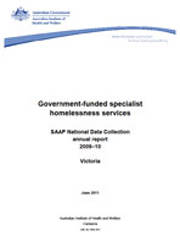Summary
This publication is one of eight state and territory supplements that accompany the 2009–10 national annual report on the use of government-funded specialist homelessness services (AIHW 2011a). Information to aid readers in interpreting the data is presented in Box 1 and in the national report and appendixes (AIHW 2011i).
Box 1: Models of service delivery vary by jurisdiction
The approaches to delivering homelessness services vary between jurisdictions (see AIHW 2011a:Box 1.1). This variation needs to be considered when analysing national results and comparing the states and territories.
Accommodation related data for Victoria, both in regard to the assessed need for accommodation and the provision of accommodation, is affected by the model of homelessness service delivery used in this state. Much of the specialist homelessness accommodation in Victoria is provided through the complementary Transitional Housing Management (THM) program, which collects data separately to the SAAP NDC. As such, accommodation related data in Victoria has not been recorded in the SAAP NDC in a basis consistent with other states and territories and is therefore not strictly comparable with that reported by other jurisdictions.
In line with the national picture, in Victoria:
- the majority of clients were female
- the average age of clients was in their early thirties
- Aboriginal and Torres Strait Islander people were over-represented relative to their population size
- clients commonly sought support because of interpersonal relationship, accommodation, or financial related issues
- immediately following support, most clients were living in a house or flat, they were not employed, and their main source of income was a government pension or benefit.
Some other points of interest in Victoria were:
- the rate of use of specialist homelessness services was higher than the national average
- the length of support was the shortest nationally
- the proportion of Aboriginal and Torres Strait Islander people was the lowest nationally
- seeking support primarily because of domestic or family violence was relatively high and has increased in recent years
- there was a relatively high level of unmet need for specialist services, such as drug or alcohol support or intervention and specialist counselling.



